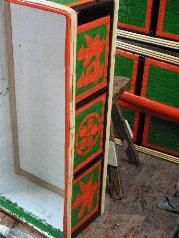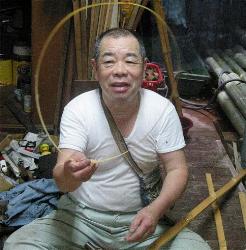|


| Attention to Akeni
|

|
Carolyn Todd
SFM's newest addition to the writing staff takes an
in-depth look at akeni, their history and production techniques
|
|
| Rikishi of Old
|

|
Joe Kuroda
Joe Kuroda slides former yokozuna Minanogawa under his SFM microscope |
|
| Eric Evaluates
|

|
Eric Blair
Eric's wit scythes through the SML and makes clear his opinion of where the future lies for online sumo forums. |
|
Eternal Banzuke Phase II
|

|
Lon Howard
Stats, equations and mathematics all lead to a list of sumo's most prolific up and downers
|
|
|
|
|
Heya Peek
|

|
Mark Buckton
Mihogaseki, former home of Estonian sekitori Baruto is toured (and peeked at) by SFM's Editor-in-Chief
|
|
|
|
|
|
|
Nagoya Basho Summary
|

|
Lon Howard
Lon gives us his Nagoya basho summary, along with the henka sightings results
|
|
|
Lower Division Rikishi
|

|
Mikko Mattila
Mikko Mattila casts his watchful eye over lower division goings on in makushita and below.
|
|
|
Aki Ones to Watch
|

|
Carolyn Todd
Carolyn takes over the job of rikishi job performance prediction for SFM as she looks at those to keep an eye on come September |
|
|
Kimarite Focus
|


|
Mikko Mattila
Our man Mikko's latest trio of kimarite get thrown about the SFM literary dohyo |
|
|
Amateur Angles
|


|
Howard Gilbert
Howard returns with the second of his columns on the amateur sumo scene.
|
|
|
Sumo Game
|

|
| SFM's very own quiz comes in for a bit of self scrutiny by our secretive man of questions. We'll call him 'X'. |
|
|
Sumo in Print
|

|
Barbara Ann Klein
SFM’s Editor reviews “The Little Yokozuna”, a book for “young” (and older) adults
|
|
| Kokugi Connections
|

|
Todd Lambert
Check out Todd's bimonthly focus on 3 of the WWW's best sumo sites
|
|
Fan Debate
|
 
|
Facilitator - Lon Howard
Keri Sibley and Eduardo de Paz ponder the concept of ‘to pay or not to pay’ makushita salaries
|
|
SFM Cartoons
|  |
Stephen Thompson
Sit back and enjoy the offerings of one of sumo's premier artists |
|
Lets Hear From You
|
 
|
| What was it that made you a sumo fan? SFM’s own Todd Lambert details his path into sumofandom
|
|
|
|
| Sumo Quiz |
The Quizmaster
Answer the Qs and win yourself next basho’s banzuke. |
|
|
|
 |
|
had no children to continue the business. When Mr.
Omura in Tokyo retired, there was too much work for 70-year-old Mr.
Mioshi, and a local kesho mawashi maker asked Mr. W if he would
consider taking on the responsibility. Mr. W admits that he was
reluctant, but as a craftsman, he was obliged to agree in order to
preserve the tradition. In October 1989 he made a sample akeni and took
it to the NSK in Tokyo as an example of his work, and he officially
began to make akeni just before the 1989 Kyushu basho.
Mr. W is a perfectionist and he noticed that previous akeni were quite
rough in texture compared to his work, which is extremely smooth. He
changed the weaving technique to conform to his own style and to
refine the quality of akeni. Even now, if he’s unhappy with his own
work, or that of his wife or son, he’ll reject the piece and start
again. He’s even been known to virtually confiscate earlier akeni
that do not
meet his standards and take them back to the workshop for remodelling.
|

|

|

|
Now, if I had the responsibility of akeni tradition resting on my shoulders, I’d be a mite
nervous, but when I entered the W workshop, the atmosphere was very
relaxed. Mr. W, his wife and his son each have a space on the floor
where they carry out their various tasks. Running along the full length
of one wall are lengths of green bamboo waiting to be peeled and
sliced. And in the background? A portable TV showing day 11 of the
Nagoya basho. The first smells to hit me were glue and lacquer and I
wondered for a moment whether this could explain the relaxed state, but
it was obvious that the family is just happy with what they do and supremely sure of their skills.
Before Mr. W
took over akeni production, the boxes had been painted in quite dull
colours of black and dark green. To celebrate the new era, he honoured
the city of Kyoto by changing to bright green and vermilion, the colours of the Heian Shrine.
This colour scheme is also more in keeping with the bright colours of
|

|
|

|
 Gyoji akeni
Gyoji akeni
kesho mawashi and is apparently popular with the sekitori.
Thirty
processes are involved in making one akeni. If you convert this into
hours, it takes about one full day to complete, although in reality
they’re made in stages.
The most
difficult work is splitting the bamboo. Mr. W uses the moso variety,
which is ideal because it is flexible. Long lengths of 12cm diameter
bamboo are split into 10 equal portions, peeled and then sliced. A
different thickness is necessary, depending on the type of box. The
smaller the box, the thinner the bamboo has to be – about 7mm for akeni
and 1mm for letter boxes; these slices are so thin that you can see
through them. If the bamboo can be bent into a circle, the thickness
and the slice are even. It takes a minimum of 10 years to learn how to
slice bamboo so thinly and today, only Mr. W and his son have this
skill in Japan. A craft school in Kyushu where students work with
bamboo has invited Mr. W to instruct them, but he’s too busy to go for
even a week, although they ask him every year.
Next
|
|






